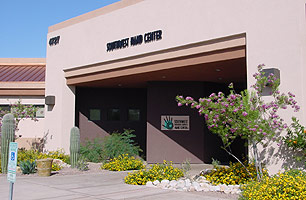
This information is being recorded so that other patients expecting carpal tunnel surgery will better know what to expect in the process. There are several web sites giving the surgeon's point of view. This is the view from the receiving end of the scalpel.
Events leading up to the hand surgery:
It all started with a numbing or tingling in the hands that comes and goes. For a few years it was tolerated until it became a real annoyance and hindrance in my work. I design and manufacture high end/exclusive apparatus for magicians. These items can involve using two ton machines or even fine watchmakers' tools. I NEED my hands and I NEED them to be sensitive to what they are touching. Feel is a very important part in making fine items.
After putting up with things for too long, I had my regular doctor refer me to a hand specialist to see if he could determine the problem and hopefully correct it. I was referred to Dr. William S. Smith of the Southwest Shoulder, Elbow, and Hand Center here in Tucson, Arizona.

I have always considered having to wait in the doctor's office part of the normal routine. I was in for a surprise. When I got to the hand clinic, I checked in, showed my health insurance card, and turned to sit down. That idea of sitting was a joke. I barely walked over to a chair when I was called. I was interviewed by a friendly medical assistant, Carlos Cota, and x-rays of my hands were taken to determine if arthritis or some other such problem might be causing the hand numbness and tingling. It turned out that nothing out of the ordinary showed up on the x-rays. The doctor had me hold my arms/hands in position for about a minute to see if that would reproduce the tingling. It did not. So far, nothing exhibited itself as a suspicious cause.
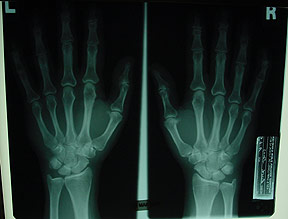 The hand x-rays
The hand x-raysI was then scheduled to have a neurologist do a nerve test to determine if there were nerve problems. I showed up for this appointment on time and, once again, did not have a chance to get seated in the waiting area. I love the efficiency! This nerve test involved the neurologist, Dr. Harvey Goodman, sending weak electric currents along the hand/arm to see if the nerves are working as they should be. My wife would probably jump off the table with these small shocks. Since I have played with Van De Graff generators and high frequency Tesla coils since childhood (even making The Incredible Electric Woman Illusion for sideshow performers), the shocks were absolutely nothing to me - not even annoying. This test is not bad at all and turned out to be rather revealing. Another appointment was scheduled for the hand doctor to discuss the results of these tests.
I showed up for this appointment a little early as usual. Again, I was never given time to get a seat in the waiting area. I was immediately ushered back to a small consulting room to await the hand doctor with news from the neurologist. The news was that the interpretation of the EMG Nerve Conduction test was:
1. Very severe median entrapment at both wrists. Thenar muscle irritability. No denervation. The left is worse. (I am mostly left handed)
2. Normal ulnar and radial studies.
My response to Dr. Smith was, "What's the next step?". Surgery on my left hand was immediately scheduled for the following Wednesday morning at 10. At this time I was asked to sign the authorization and consent form. This form is to inform the patient of possible risks - to include possible death! How many times do you get a chance to sign your own death certificate? It's surgery, after all, and risks are implied by the term "surgery". Either you trust your doctor or you do not. I signed the form and had a good laugh.
A couple days before the surgery I was called to see if I could come in for 9 A.M. surgery rather than 10 A.M. as they needed to do an involved operation on someone else. I said fine.
The Surgery:
The next 5 days I suspended taking a daily baby aspirin (blood thinner) and for at least 8 hours before the surgery, I was to eat and drink nothing. This is the easiest "prep" I have ever heard of! I needed to arrive 2 hours early at El Dorado Hospital Outpatient Surgery Center to be prepared for the surgery. At 7 A.M. I checked in. After about a two minute wait, I was asked to sign in with the "finance people". It was in chatting with the person handling the paperwork that I found out that the surgicenter is not part of the hospital, but rather, privately owned by 27 different doctors. To me this was a good sign as it meant they had a very real interest in providing quality medical care. Here I received my first "bracelet" - after being asked if everything was correct and which hand would get operated on.
Now I needed to wait for about 10-15 minutes before being called back to the "staging area". I really must point out that the surgicenter has the absolutely worst selection of magazines I have ever seen. I finally found one that might be of interest to males. When I opened it to read it, it looked like swiss cheese! Articles and coupons had been cut out on about every other page! Fortunately, I did not have a long wait.
I was ushered back into the staging area and taken to a small room with a gurney, blood pressure equipment, etc. Here I was to put on a gown and place my posterior into the "V" of the rolling bed. I asked the nurse what other body part I could possibly put there and still be on the bed. Evidently, some patients slouch down rather than firmly planting their butts in position. I changed into the gown and positioned myself correctly. The nurse next explained to me the procedure I would be going through. She placed a large "X" on my left forearm to indicate that this was where the action would take place. She asked if all of the bracelet info was correct and gave me another bracelet indicating drugs that I am allergic to. An IV was started in my right hand and a needle was inserted into my left hand. This was for introducing the pain blocker during surgery. The backs of both hands were rubbed with a topical numbing solution before the needles were inserted. Having these two needles hooked up is no pain - just a little pricking sensation.
I must interrupt this description of events to explain something about nurses. They all have something in their genes that requires them to cover patients with a blanket - no matter how warm the patient is! Fortunately, this wonderful nurse understood that I did not want the blanket on my legs. She HAD to cover them first before removing the blanket though. We both had a good laugh at this. I really must comment upon the nursing staff that I was exposed to while there for my hand surgery. They were all extremely friendly, caring, and professional. This first nurse explained what all would be happening and left me to wait until they were ready for me. She kindly came back to report status of things and let me know how long it would be before I was taken into the operating room. I appreciate the fact that there were no surprises. Everything went like clockwork. When my turn neared, the anesthesiologist came in to explain what would be done and how I would feel during and immediately after the surgery. Here was another kind, caring professional. A few minutes later the surgeon (my hand doctor) came in to fill out paperwork, check it, make certain the correct arm was marked, mark the palm of my left hand with two dots, and to greet me. By the time I was rolled into the operating room, I was fully aware of what to expect and knew who would be doing what.
After being rolled into the operating room, I was, of course, covered with the blanket. This was fine as it is always cooler in an OR and covered legs are more sterile. Once in the operating room, things moved quickly. The anesthesiologist hooked me up to oxygen, attached sensors, and got set up for administering medication as needed. I glanced over at my left hand in which had been placed a roll of something for me to hold (I missed seeing that - they moved so fast). The nurse had already wrapped my left hand and forearm with a blue (blue is my favorite color - nice touch) rubber bandage 3" or so wide to act as a tourniquet (to retain pain killer in the arm/hand areas or possibly to help control bleeding during the surgery?). I never knew my arm was so skinny! I looked like a blue Egyptian mummy! It seemed comical to me that I had previously signed a consent form which included the possibility of death and here they were wrapping me up to be mummified! I enjoy the humor in such connections between things. Here is when the anesthesiologist told me that I'd feel a burning in my arm as the medication (I'll call it knock out juice) was administered. He was right, it did burn as it entered my vein. This was not painful, but it did cause a burning sensation. That is all I remember until I came out of it a couple minutes later and felt the incision being made in my hand. I asked the anesthesiologist, "Am I supposed to feel the incision?" He added a little more knock out juice - more burning sensation (that's what I get for asking a question during surgery). I really need to mention here that when I felt the incision being made, it was not overly painful - just an interesting feeling. The next thing I knew, they were rolling me out of the operating room. "Watch out for the light"! was uttered by one of the staff as I was rolled under the large operating room light and back to the staging area.
After the surgery:
From the operating room I was rolled back to a different section of the staging area to be monitored as the medications wore off. A different nurse (equally interesting, caring, and professional) talked me through this stage of the procedure. We had a nice chat as she did her thing. I made certain my thumb and fingers were all there and moving (instant relief!). There were several electrode connectors stuck onto my chest. These needed to be removed. My nurse was hesitant to pull them from my hairy chest (these people are caring). I said to do it quickly in one yank. She hesitated on one - ouch! The others went smoothly. She then gave my wife a call to let her know I'd be ready to be picked up in about 15 minutes. After a final blood pressure reading and some cool orange juice, I was told I could get dressed to leave. The nurse indicated that she could help with buckles etc. if needed. Being a rather private and modest individual, I told her I could get things OK. Well, let me tell you it is rather difficult to put on a pair of cargo shorts with a button fastener and one numb hand! I finally got it before having to call for help. Whew! That was close!
As I walked to the pickup area, my wife walked in - perfect timing.
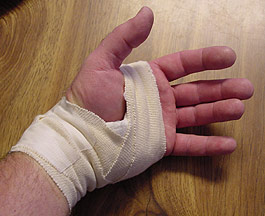 Here is my left hand immediately
after surgery - fingers and thumb are free to move.
Here is my left hand immediately
after surgery - fingers and thumb are free to move.In the few hours after the surgery, my hand experienced the expected tingling as feelings returned. I was given a prescription for pain pills with my discharge paper. I figured I would not need too many of the pain pills as I do not particularly like taking such things. I fully expected my hand to hurt and throb all day and the following evening. I never felt a need for any pain killers; but I should point out that I know I am not as sensitive to pain as many people. The hand was uncomfortable; but never really bothered me. I kept it elevated all the rest of the day to avoid swelling. You might be more sensitive to pain and want or need a pain medication. Mention this to your doctor or nurse while you are still in the staging area. By evening, I still could not pick up a can of soda with it. I decided to wear a hand splint on the hand (over the bandages) while sleeping so that I would not accidentally rub off the bandage. It did not bother me at all the whole evening. By the next day, I was able to pick up a glass and actually eat with my left hand. I am typing this the end of day one after the surgery. I feel no pain as I do this. Picking up heavier items will cause hand pain. I do feel that recovery will be faster than anticipated. I am pleased. You will be warned about not eating too much. I experienced no stomach problems due to the medication> I think it even made me hungry!
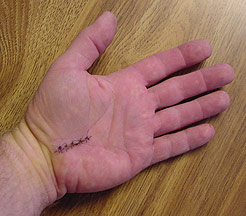 Here is my hand after 3 full days
- doing nicely.
Here is my hand after 3 full days
- doing nicely.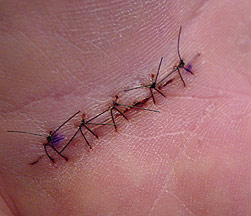
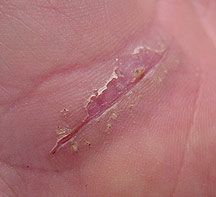 Two weeks later
- stitches are out.
Two weeks later
- stitches are out.Some concluding thoughts:
1. Wear pants to the surgery that are elastic waisted and do not require snapping or buttoning.
2. I felt the whole experience was an interesting and positive experience.
3. Every single person I came into contact with was caring and professional - from the receptionist to the surgeon. I could not have asked for better medical care.
4. The staff worked like a well oiled team - very impressive. I love efficiency!
5. I hope all goes as well with my right hand in a few weeks. I am mentally ready.
Problems:
1. Waiting room magazines in the surgicenter are the pits.
2. Unless the patient has a well padded posterior, the gurney gets rather hard while awaiting surgery.
Suggestions to make things easier for those who will undergo this procedure:
1. If your dominant hand is to be operated on, get an electric toothbrush.
2. Wear velcro strapping sandals or the like to the surgery - easy to put back on with a numb hand.
3. Maintain a sense of humor and enjoy the experience as much as possible. The medical staff is trying to help you. It is in your best interests to be cooperative with them and calm. Be considerate of them as they are hard working and dedicated people. Treat them as you would want to be treated. I found the staff working on me to be delightful.
4. If you are at any time in pain, tell someone. The staff can not do anything about pain if they are unaware of the problem. Over reacting will help nothing.
5. Do not fret over the surgery. Take advantage of the situation, relax, and enjoy things as much as you can.
Well, the right hand was another adventure. I never received the arm burning "knock out juice"; but was given something to "relax' me. I did not know I was keyed up! Apparently, most of the numbing medication was administered through the needle in the back of my right hand. I felt nothing in my hand; but could feel that something was being done with the hand.
During surgery, the doctor did comment that there was not much clearance in this hand. Immediately after the surgery I checked to make certain everything was there and working. It was.
Recovery was much more painful on this hand. It hurt to move the fingers into a straightened out position and there was some minor swelling. About 10 hours after the surgery, I decided I would take a pain pill. The next afternoon I stopped the pain pills.
After three days, I removed the wrappings to find this: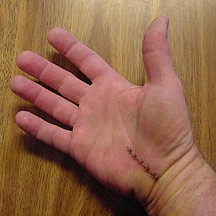 The incision is about 1/2"
longer than the one on my left hand.
The incision is about 1/2"
longer than the one on my left hand.
It does not show well in this small image; but there is bruising from the base of the thumb to the base of the ring and little fingers.
Here is a close up of the stitches: 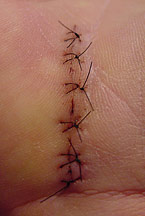
Today is the fourth day after surgery and I have almost full motion of all fingers and thumb. When the minor swelling goes down, I will be back to normal - with out the carpal tunnel symptoms. I am very pleased with whole operation. Within a month I expect to be back to a full work schedule.
After one month, I am again spinning some metal - on a limited basis (as there is still sensitivity when gripping tyhe large handles of the spinning tools. Here is what the hands currently look like.
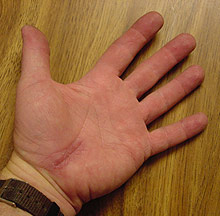 One month on the
left hand.
One month on the
left hand. 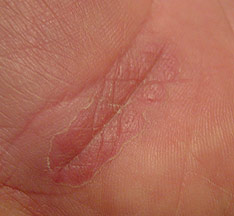
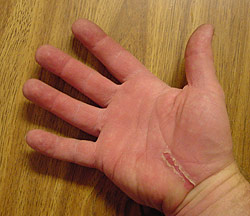 And two weeks on
the right hand.
And two weeks on
the right hand. 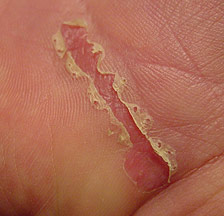
Things are healing nicely and the numbness and pain of carpal tunnel are gone. I am very pleased.